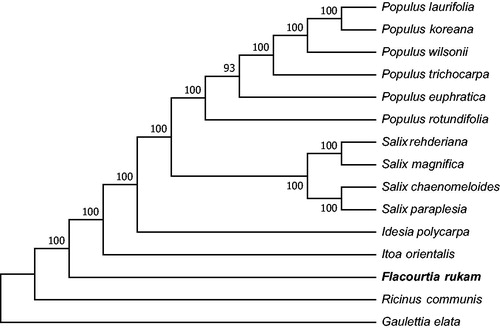Abstract
The whole chloroplast (cp) genome sequence of Flacourtia rukam has been characterized from Illumina pair-end sequencing. The complete cp genome was 155,582bp in length, containing a large single-copy region (LSC) of 83,854 bp and a small-single copy region (SSC) of 16,598 bp, which were separated by a pair of 27,565 bp inverted repeat regions (IRs). The genome contained 121 genes, including 85 protein-coding genes, 36 tRNA genes, and 8 rRNA genes. The overall GC content of F. rukam cp genome is 36.9%, while the corresponding values of the LSC, SSC, and IR regions are 34.7%, 30.8%, and 42.1%, respectively. Further, phylogenetic analysis suggested that the location of F. rukam is out of the Idesia polycarpa and is an outgroup to the genera of Salix and Populus.
Flacourtia rukam, a member of the Salicaceae family, is native to China, India, and much of Southeast Asia. It is also cultivated for its edible fruit. This evergreen tree grows thrives under hot, humid tropical conditions from near sea level up to 2100 m above sea level. In addition, as F. rukam is a Salicaceae species and has no sequencing data, understanding its genomic characteristics is important for the evolutionary analysis of Salicaceae. In this study, we assembled and characterized the complete chloroplast genome sequence of F. rukam based on the Illumina pair-end sequencing data. The voucher specimen was collected at XiShuangBanNa Tropical Botanical Garden, Chinese Academy of Sciences (101°25′E, 21°41′N) and stored at South China Botanical Garden, CAS.
The total genomic DNA was extracted from fresh leaves using a modified CTAB method (Doyle and Doyle Citation1987). The filtered reads were assembled by the program NOVOPlasty (Dierckxsens et al. Citation2017) for F. rukam using the sequenced plastome of its close relative Flacourtia_indica (GenBank accession no. MG262342) as the reference. Next, the assembled plastome was annotated using Plann (Huang and Cronk Citation2015), and the annotation was corrected using Geneious (Kearse et al. Citation2012). In addition, the physical map of the plastome was generated using OGDRAW (Lohse et al. Citation2013). The complete plastome together with gene annotations was submitted to GenBank under the accession number of MK281365. To further investigate its phylogenetic placement, a neighbour-joining tree (Saitou and Nei Citation1987) was constructed based on complete plastome sequences of 15 seed plants. Here, DNA sequences from these 15 plastomes were first aligned using MAFFT (Katoh and Standley Citation2013), and a phylogenetic tree was then constructed using MEGA (v7.0, http://www.megasoftware.net) (Kumar et al. Citation2016) with 1000 bootstrap replicates.
Our assembled plastome of F. rukam is 155,582 base pairs (bp) in size, containing a large single-copy (LSC) region of 83,854 bp, a small single-copy (SSC) region of 16,598 bp, and two inverted repeat (IR) regions of 27,565 bp. In addition, the plastome possesses total 121 genes, including 85 protein-coding genes, 8 rRNA genes, and 36 tRNA genes. Most of these genes are in a single copy, however, four rRNA genes (i.e. 4.5S, 5S, 16S, and 23S rRNA), eight protein-coding genes (i.e. ndhB, rpl2, rpl23, rps12, rps19, rps7, ycf15, and ycf2), and seven tRNA genes (i.e. trnA-UGC, trnI-CAU, trnI-GAU, trnL-CAA, trnN-GUU, trnR-ACG, and trnV-GAC) occur in double copies. The overall GC-content of the whole plastome is 36.9%, while the corresponding values of the LSC, SSC, and IR regions are 34.7%, 30.8%, and 42.1%, respectively. Furthermore, the location of F. rukam is out of the Idesia polycarpa and is an outgroup to the genera of Salix and Populus with over 90% bootstrap support (). The location of other species consisted of the previous study (Zhang et al. Citation2018) of Salicaceae phylogenetic analysis.
Figure 1. Phylogenetic relationships of 15 seed plants based on plastome sequences. Bootstrap percentages are indicated for each branch. GenBank accession numbers: Idesia polycarpa (KX229742), Gaulettia_elata (KX180066), Populus rotundifolia (NC_033876.1), Populus euphratica (KJ624919), Populus koreana (NC_037414), Populus trichocarpa (EF489041), Populus laurifolia (NC_037415), Populus wilsonii (MG262359), Salix magnifica (NC_037424), Salix paraplesia (MG262366), Salix chaenomeloides (NC_037422), Salix rehderiana (NC_037427), Itoa orientalis (MG262342), and Ricinus_communis (NC_016736).

Our study will also contribute to the study of the relationships between the species of salicaceae, so as to further understand the phylogenetic analysis of salicaceae.
Disclosure statement
The authors report no conflicts of interest. The authors alone are responsible for the content and writing of this article.
Additional information
Funding
References
- Dierckxsens N, Mardulyn P, Smits G. 2017. NOVOPlasty: de novo assembly of organelle genomes from whole genome data. Nucleic Acids Res. 45:e18.
- Doyle JJ, Doyle JL. 1987. A rapid DNA isolation procedure for small quantities of fresh leaf tissue. Phytochem Bull. 19:11–15.
- Huang DI, Cronk Q. 2015. Plann: a command-line application for annotating plastome sequences. Appl Plant Sci. 3:1500026.
- Katoh K, Standley DM. 2013. MAFFT multiple sequence alignment software version 7: improvements in performance and usability. Mol Biol Evol. 30:772–780.
- Kearse M, Moir R, Wilson A, Stones-Havas S, Cheung M, Sturrock S, Buxton S, Cooper A, Markowitz S, Duran C, et al. 2012. Geneious Basic: an integrated and extendable desktop software platform for the organization and analysis of sequence data. Bioinformatics. 28:1647–1649.
- Kumar S, Stecher G, Tamura K. 2016. MEGA7: molecular evolutionary genetics analysis version 7.0 for bigger Datasets. Mol Biol Evol. 33:1870–1874.
- Lohse M, Drechsel O, Kahlau S, Bock R. 2013. Organellar Genome DRAW – a suite of tools for generating physical maps of plastid and mitochondrial genomes and visualizing expression data sets. Nucleic Acids Res. 41:W575–W581.
- Saitou N, Nei M. 1987. The neighbor-joining method: a new method for reconstructing phylogenetic trees. Mol Biol Evol. 4:406–425.
- Zhang L, Xi Z, Wang M, Guo X, Ma T. 2018. Plastome phylogeny and lineage diversification of Salicaceae with focus on poplars and willows. Ecol Evol. 8:7817–7823.
